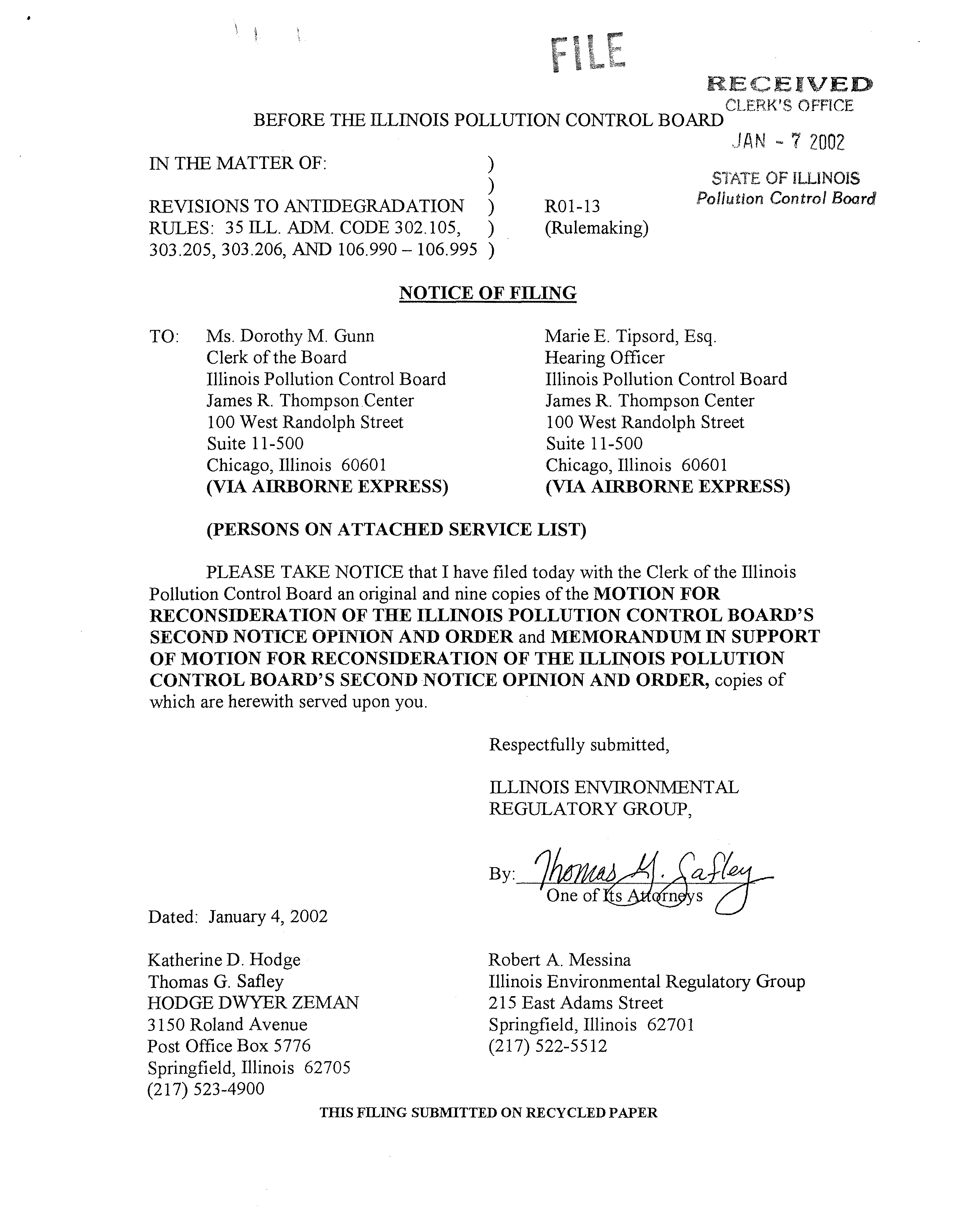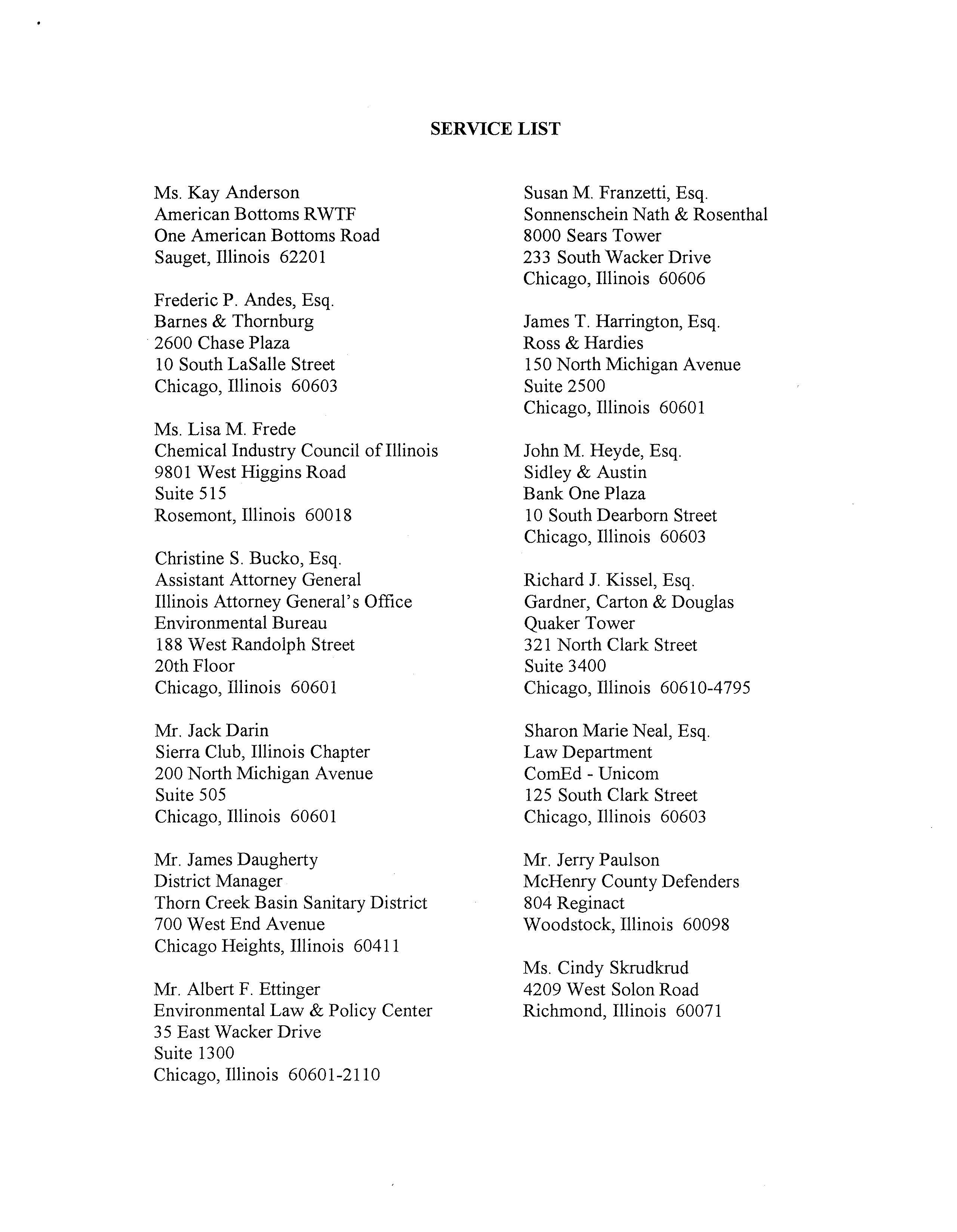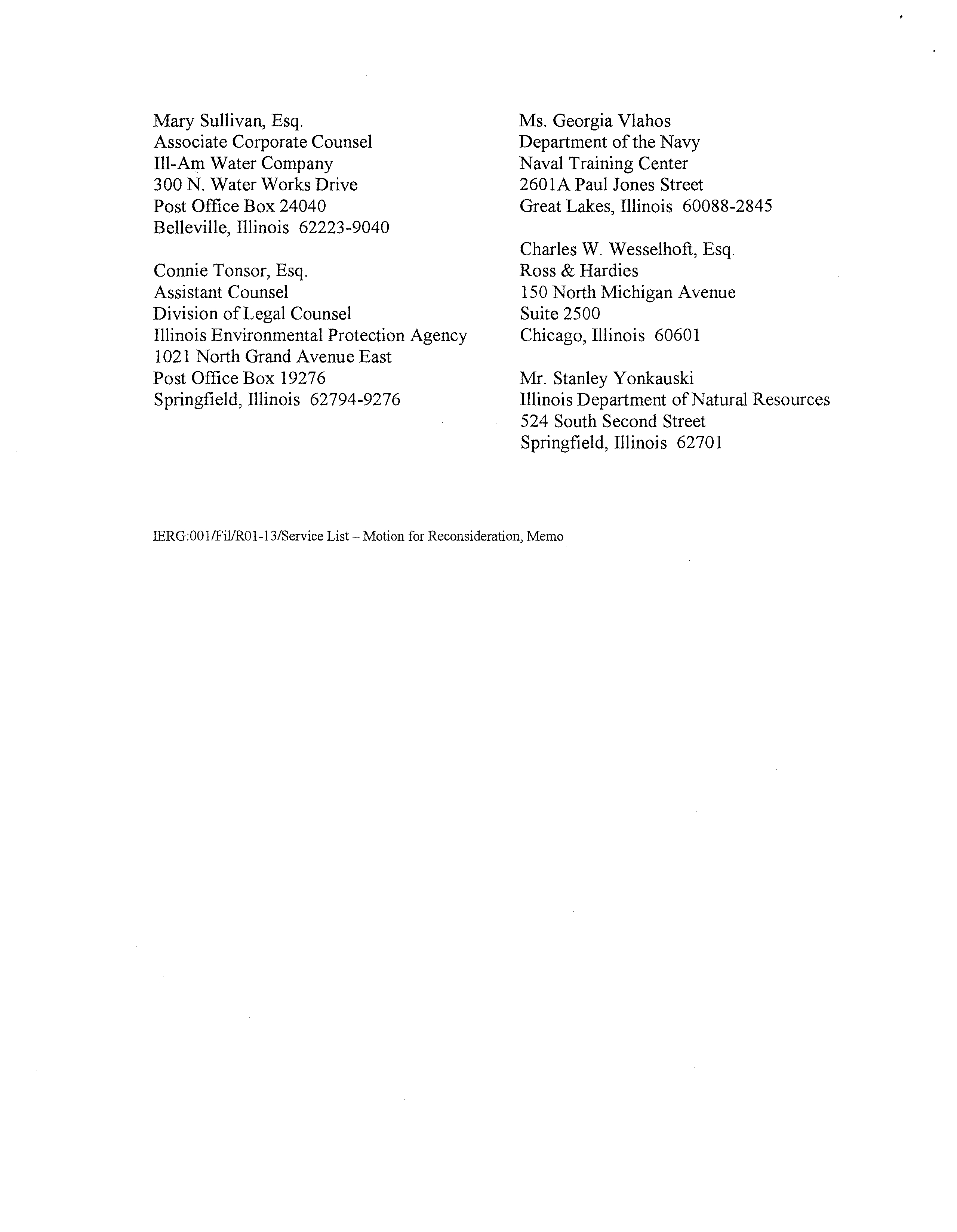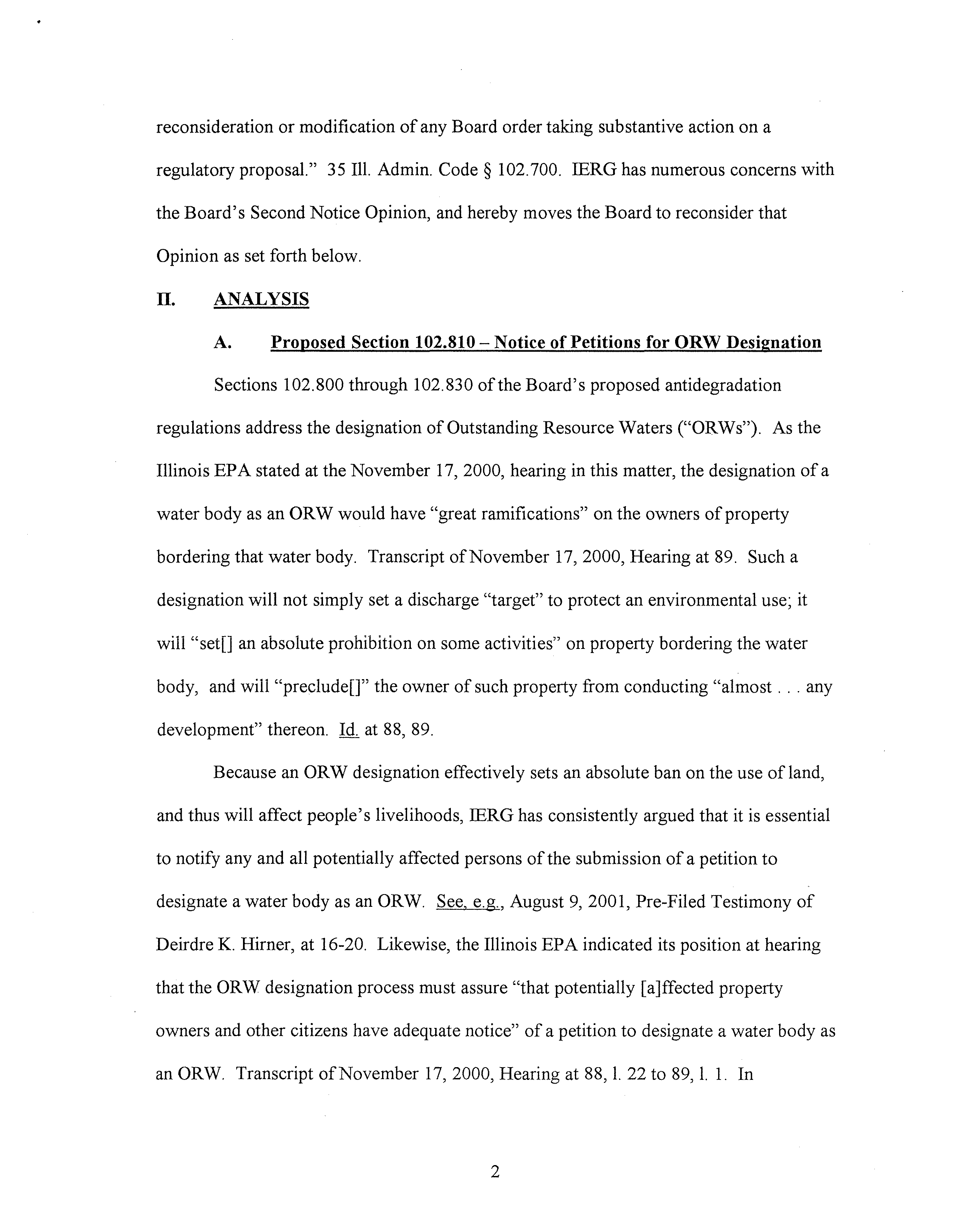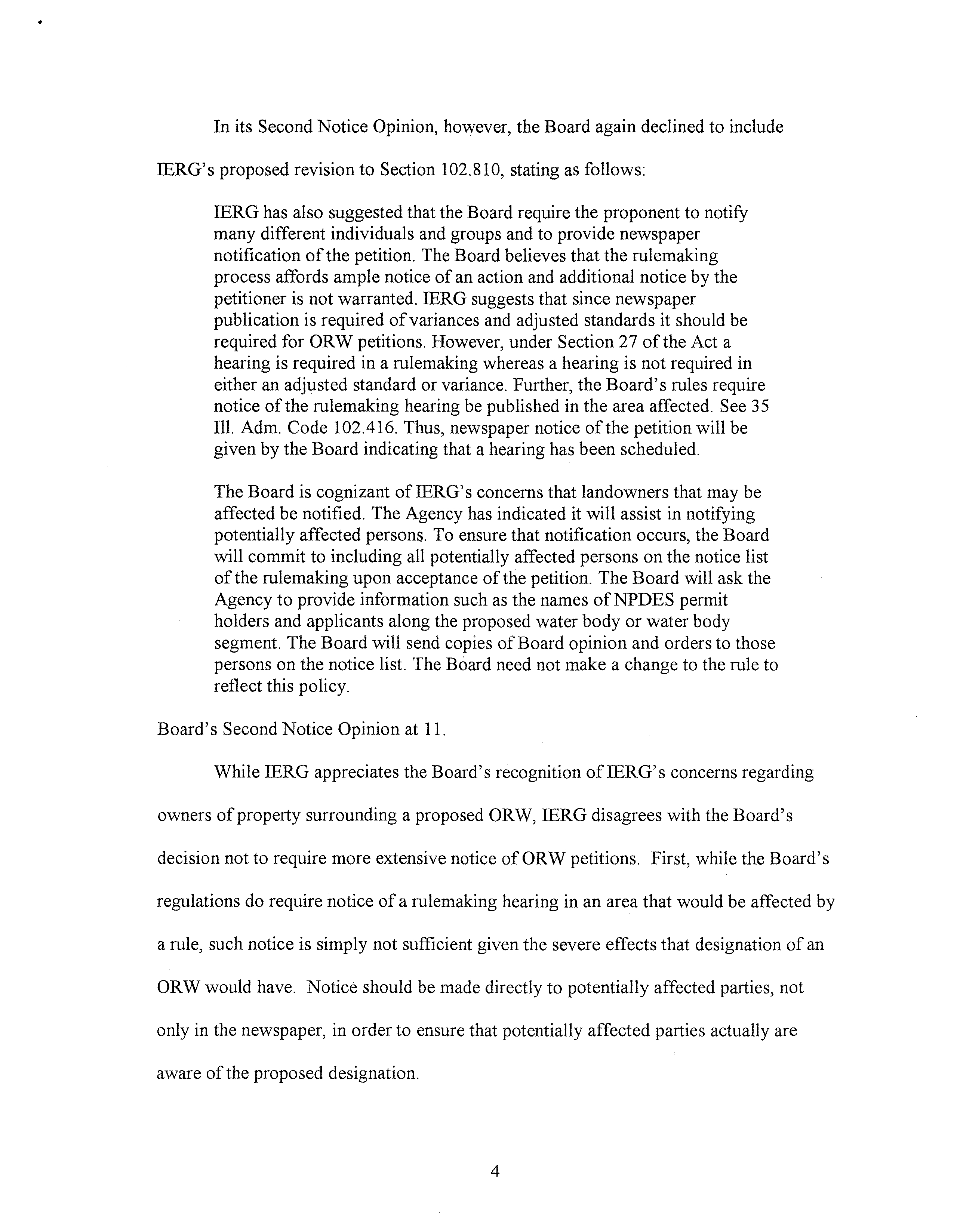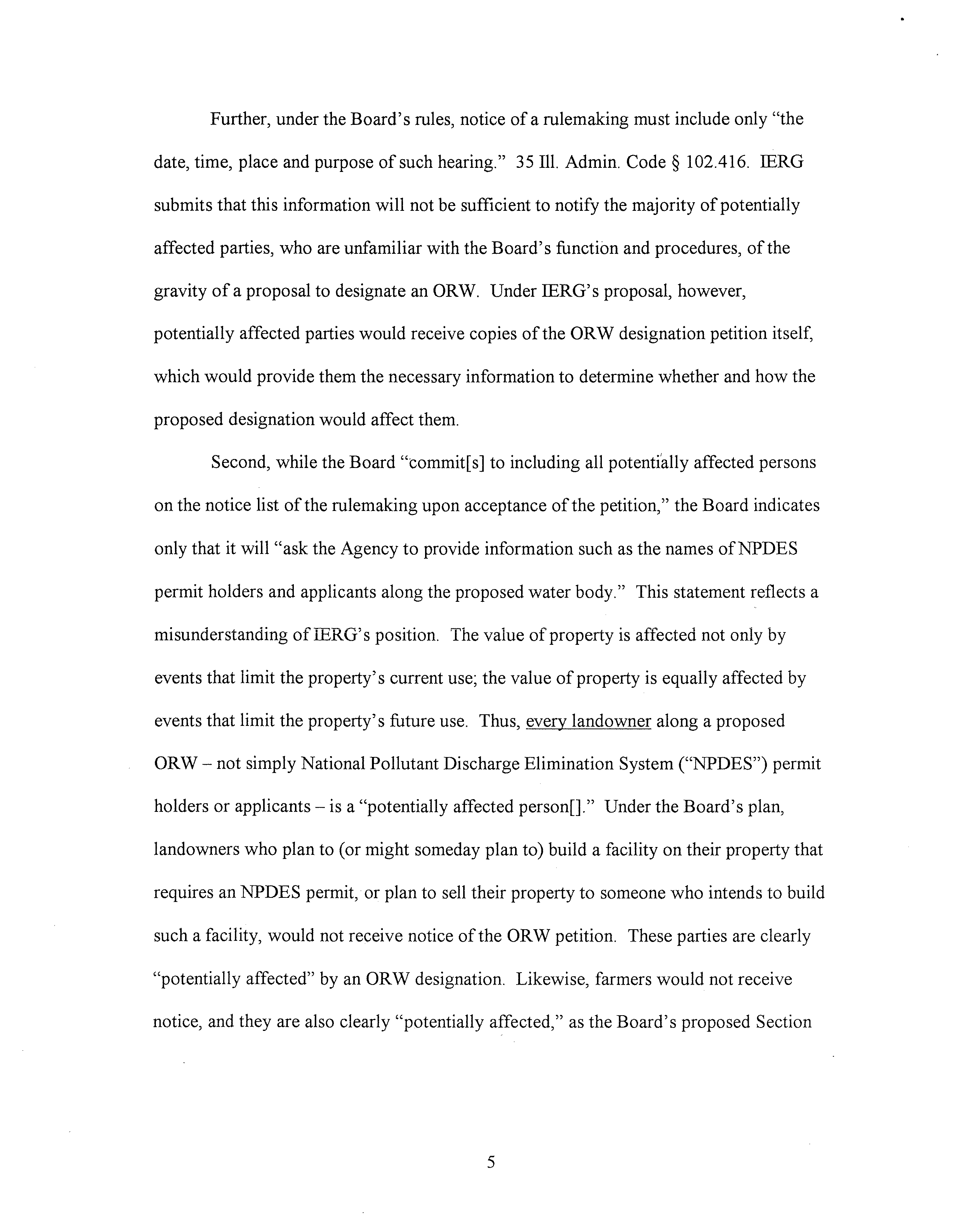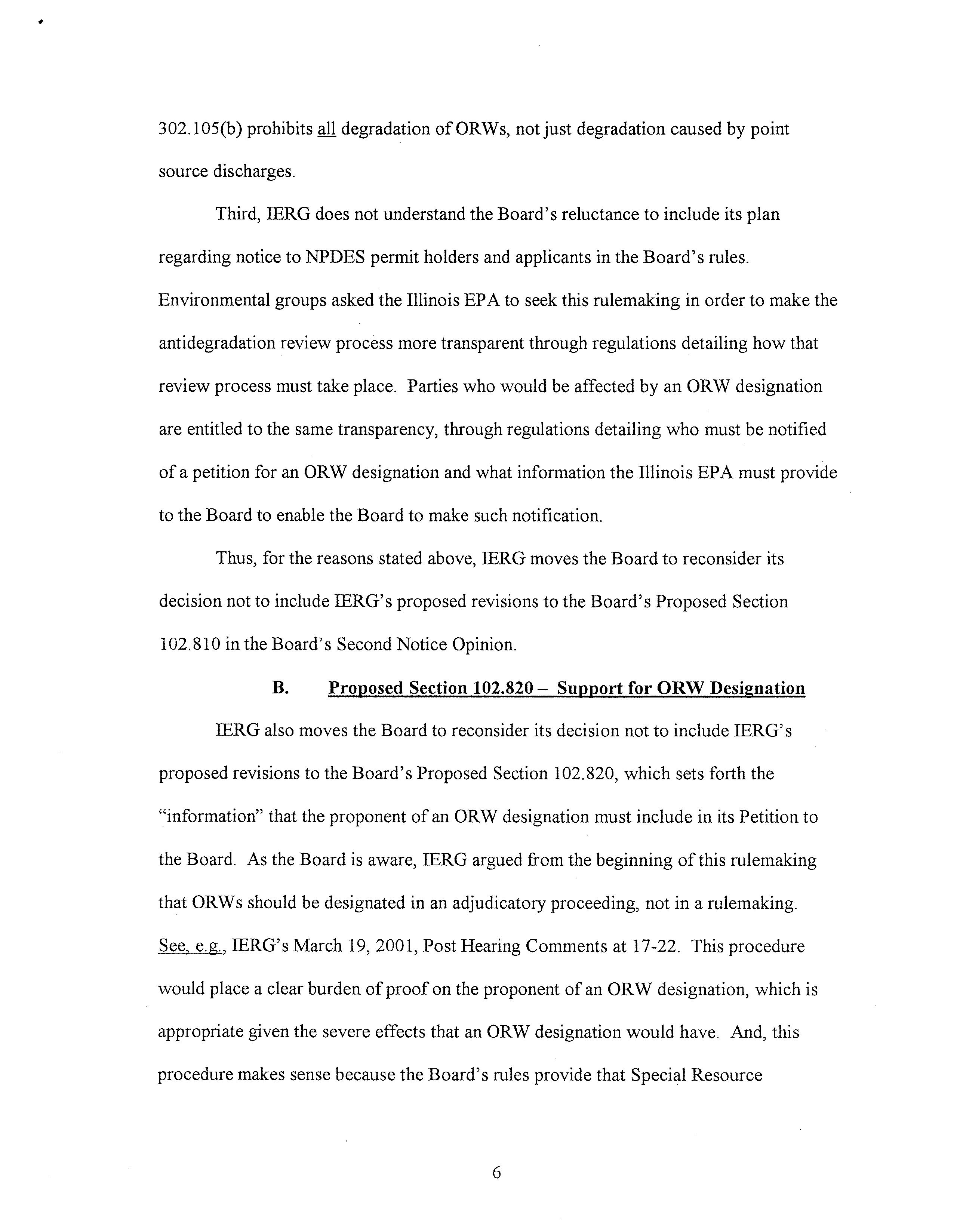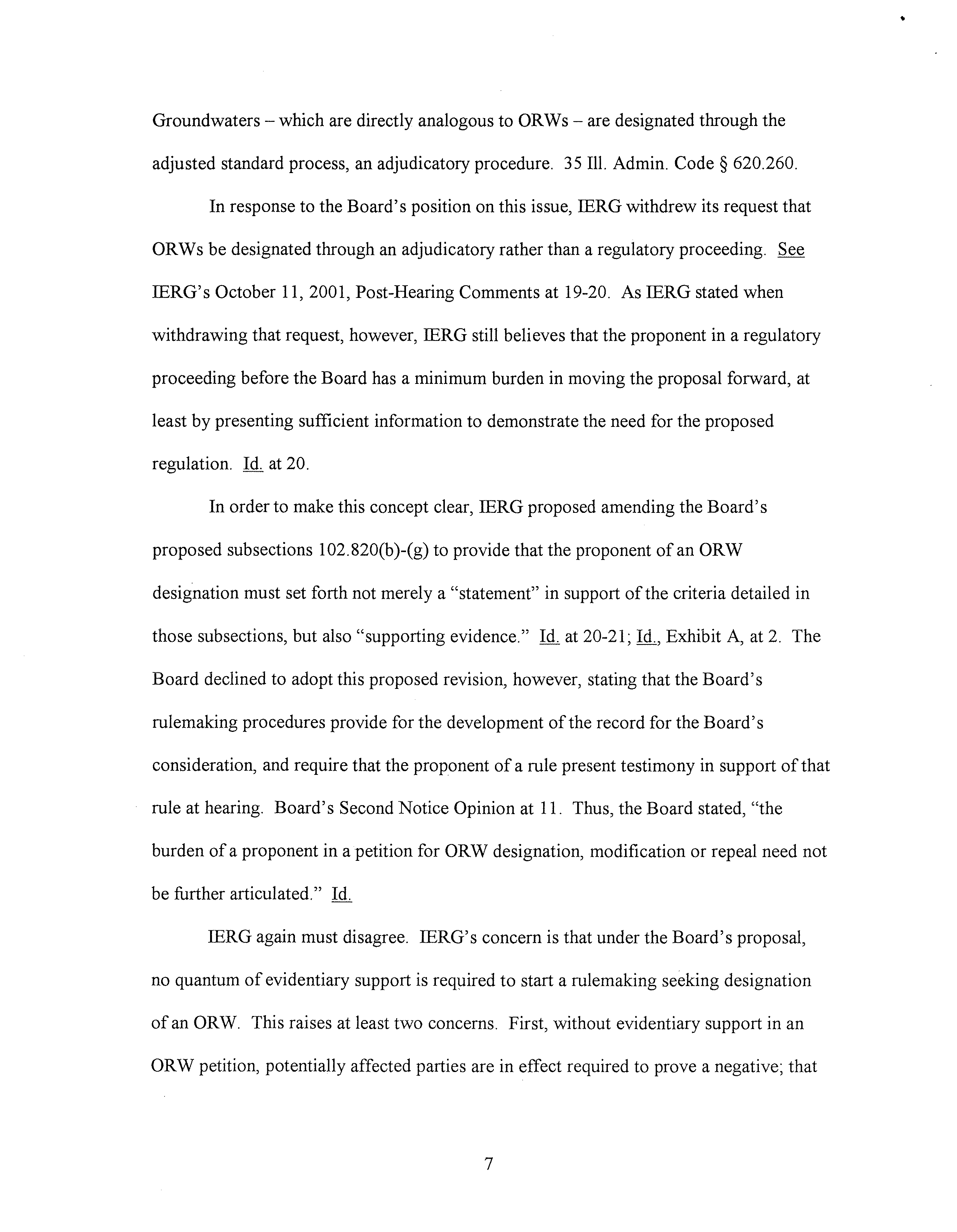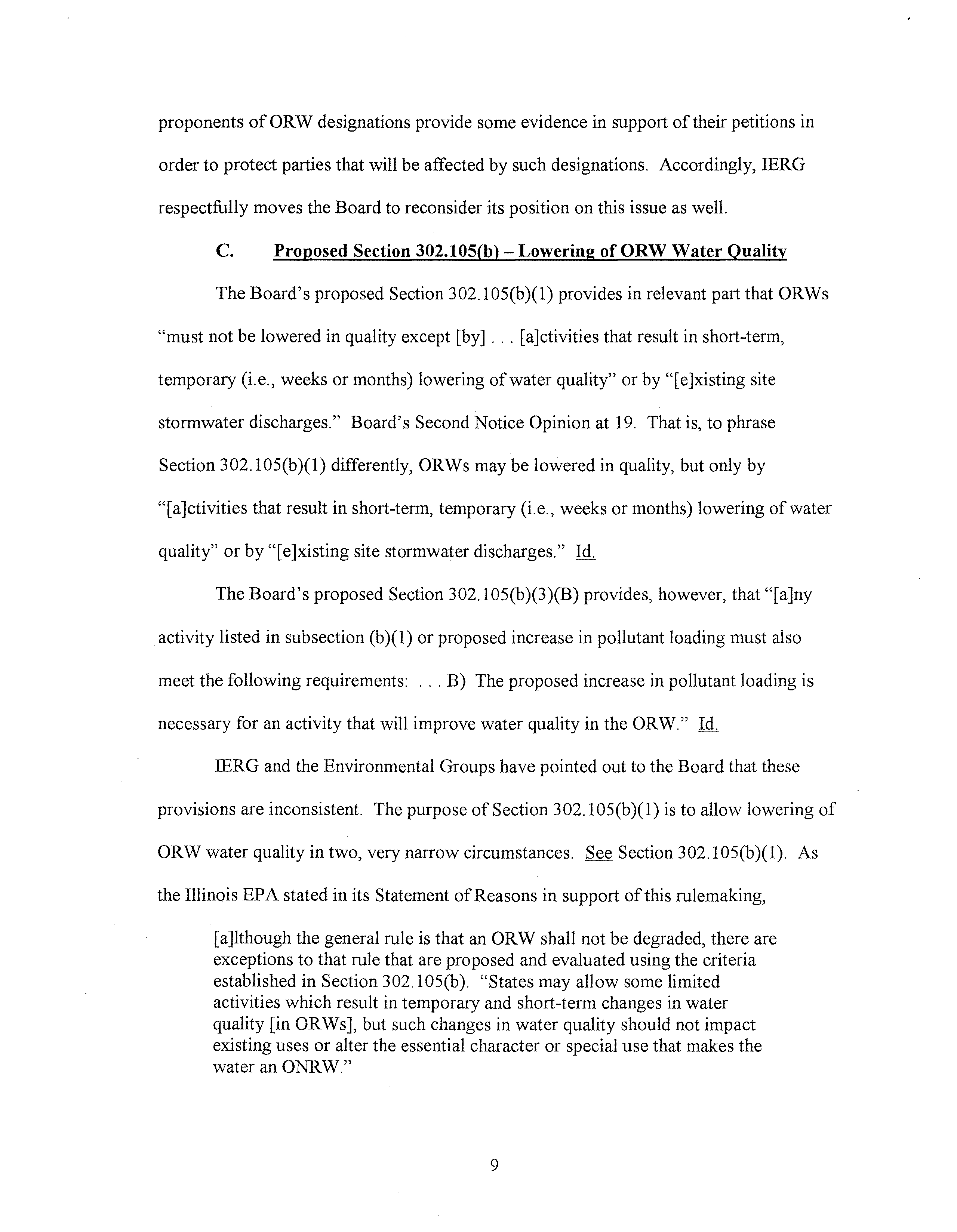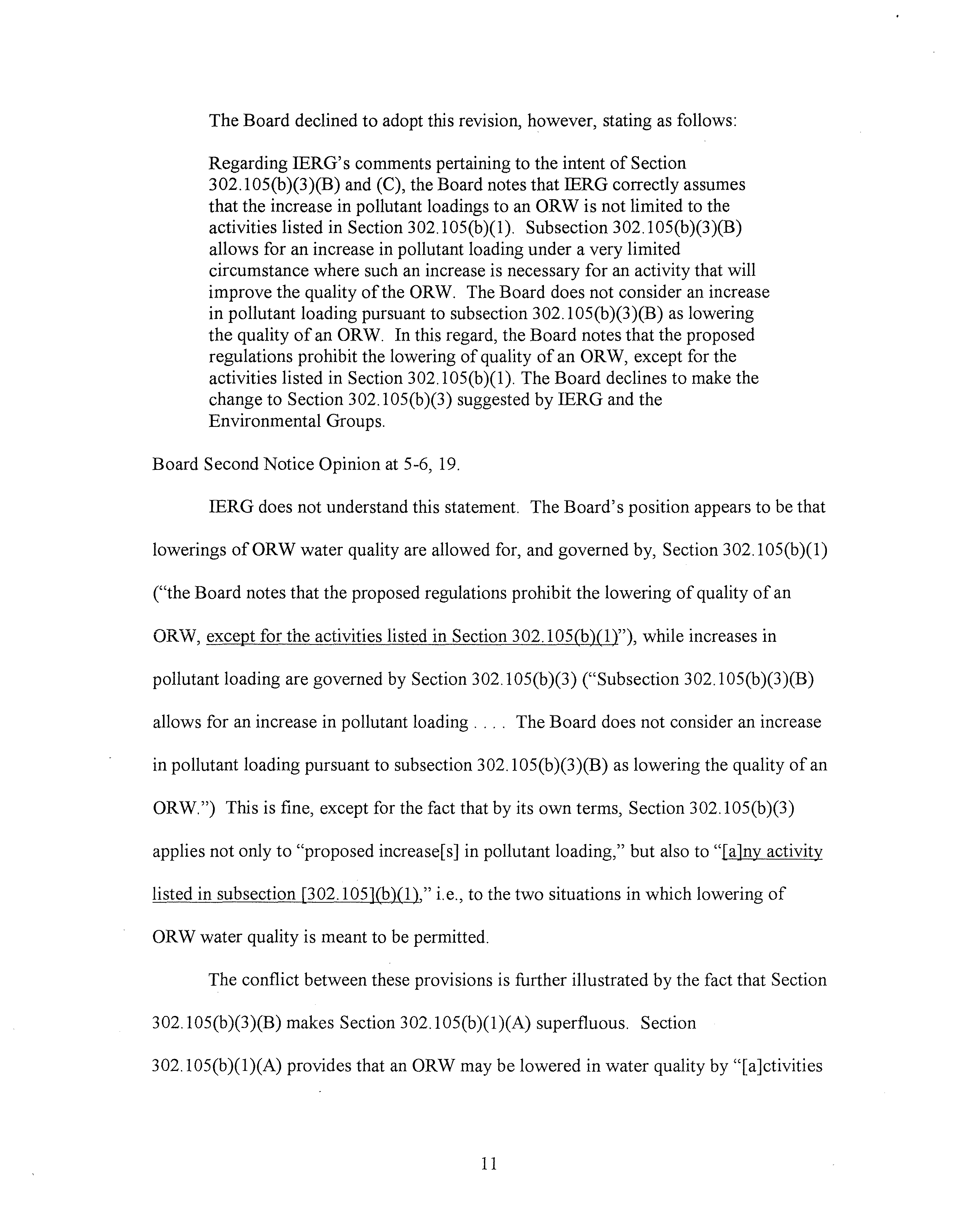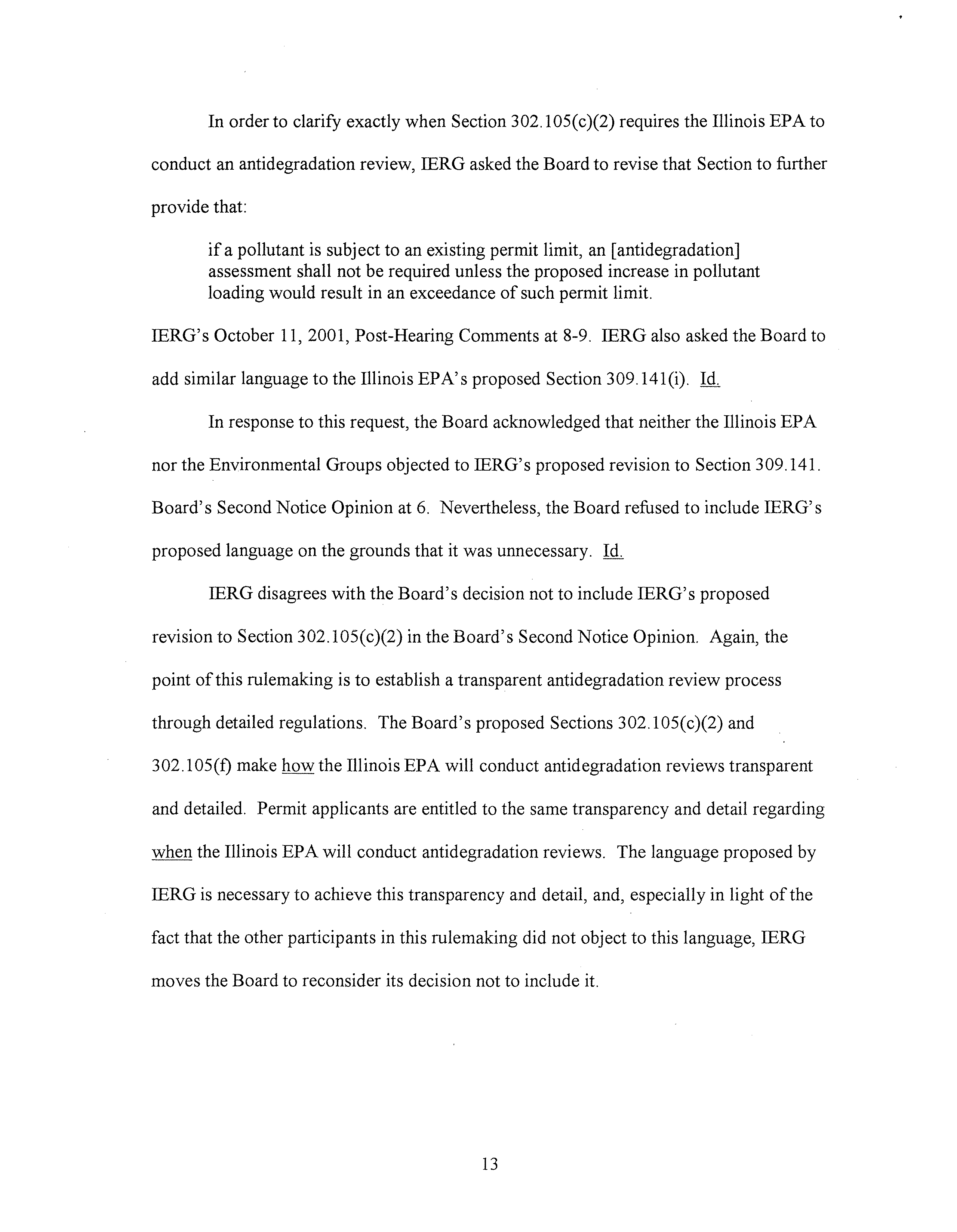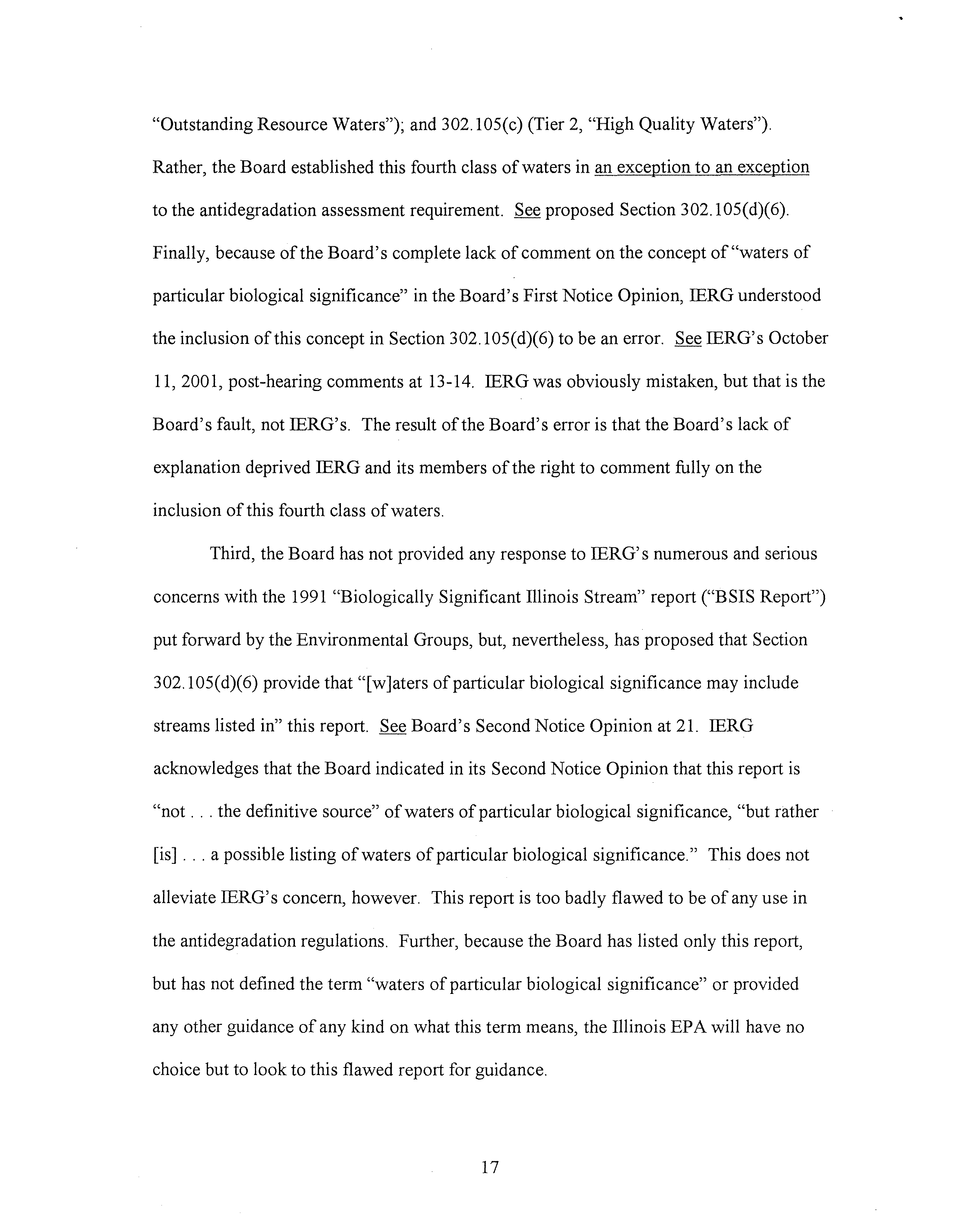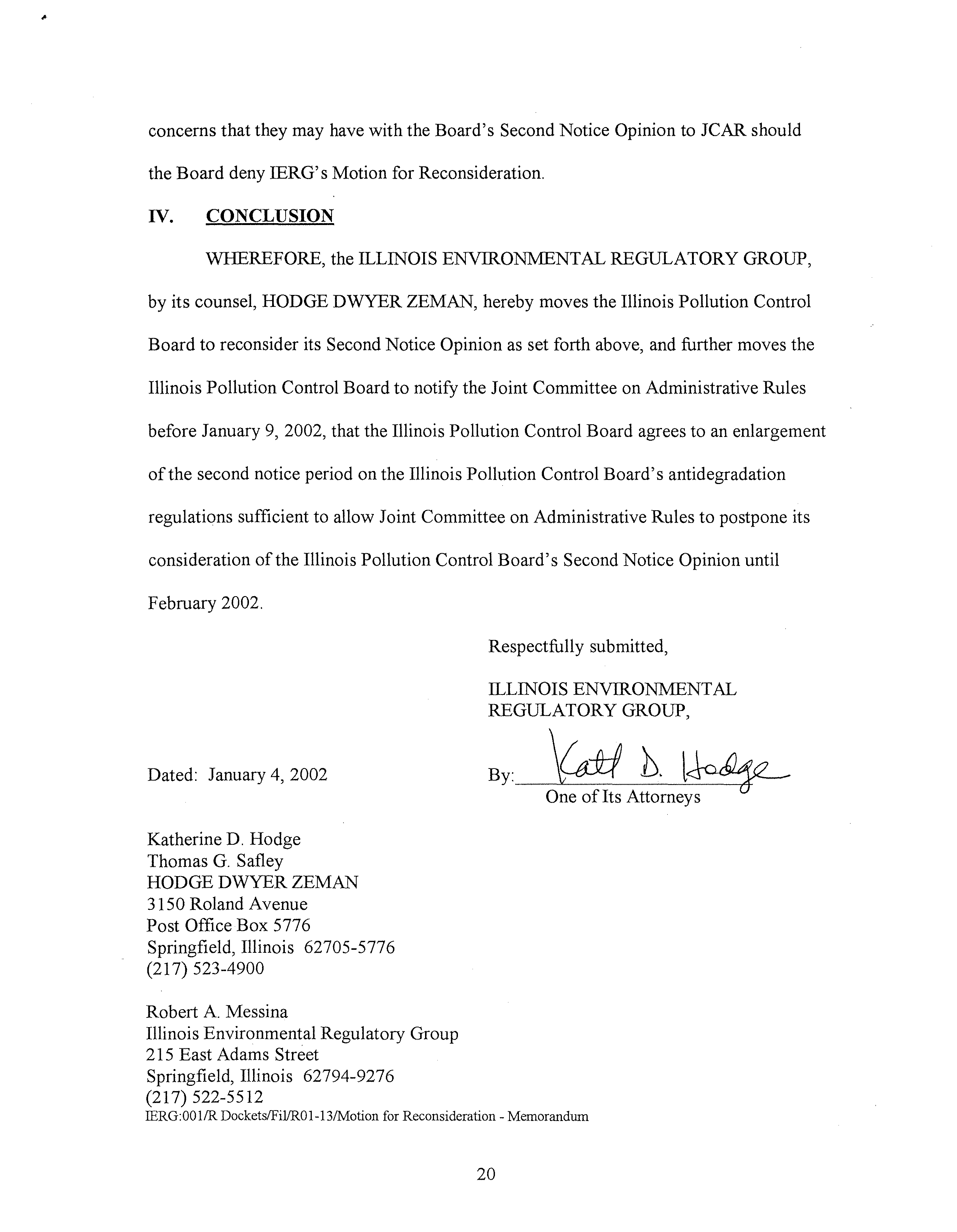I
~
BEFORE THE ILLiNOIS POLLUTION CONTROL BOARD
IN THE MATTER OF:
)
)
REVISIONS TO ANTIDEGRADATION
)
RULES:
35
ILL. ADM. CODE 302.105,
)
303.205, 303.206,
AND 106.990
—
106.995
RECEIVED
CLERR~S
OFFICE
JAN
7
200?
STATE OF ILUNOJS
R01-13
Pollution
control
Board
(Rulemaking)
NOTICE OF FILING
TO:
Ms.
Dorothy M.
Gunn
Clerk ofthe Board
Illinois Pollution Control Board
James R.
Thompson Center
100 West Randolph Street
Suite 11-500
Chicago, Illinois
60601
(VIA AIRBORNE EXPRESS)
Marie E.
Tipsord,
Esq.
Hearing Officer
Illinois Pollution Control Board
James R.
Thompson Center
100 West Randolph Street
Suite 11-500
Chicago, Illinois
60601
(VIA
AIRBORNE EXPRESS)
(PERSONS ON ATTACHED SERVICE LIST)
PLEASE TAKE NOTICE that I have filed today with the Clerk of the Illinois
Pollution Control Board an original and nine copies ofthe
MOTION FOR
RECONSIDERATION
OF
THE ILLINOIS POLLUTION CONTROL
BOARD’S
SECOND NOTICE OPINION AND ORDER
and MEMORANDUM IN
SUPPORT
OF MOTION FOR RECONSIDERATION OF THE ILLiNOIS POLLUTION
CONTROL BOARD’S SECOND NOTICE
OPINION AND ORDER,
copies of
which are herewith served upon you.
Respectfully submitted,
ILLINOIS ENVIRONMENTAL
REGULATORY GROUP,
By:________
One ofI~~f~ys
Dated:
January 4, 2002
Katherine D. Hodge
Thomas G.
Safley
HODGE DWYER ZEMAN
3150 Roland Avenue
Post Office Box 5776
Springfield, Illinois
62705
(217) 523-4900
)
Robert A. Messina
Illinois Environmental Regulatory Group
215 East Adams Street
Springfield, Illinois
62701
(217) 522-5512
THIS
FILING
SUBMITTED
ON RECYCLED PAPER
CERTIFICATE OF SERVICE
I, Thomas G.
Safley, the undersigned, certify that I have served copies ofthe
attached MOTION FOR RECONSIDERATION OF THE ILLINOIS POLLUTION
CONTROL BOARD’S SECOND NOTICE OPINION AND ORDER and
MEMORANDUM IN SUPPORT OF MOTION FOR RECONSIDERATION OF TIlE
ILLiNOIS POLLUTION CONTROL BOARD’S
SECOND NOTICE OPINION AND
ORDER upon:
Ms.
Dorothy M.
Gunn
Clerk ofthe Board
Illinois Pollution Control Board
James R.
Thompson Center
100 West Randolph Street
Suite 11-500
Chicago, Illinois
60601
Marie E.
Tipsord, Esq.
Hearing Officer
Illinois Pollution Control Board
James R.
Thompson Center
100 West Randolph Street
Suite 11-500
Chicago, Illinois
60601
by overnight delivery by depositing
said documents in an Airborne Express drop box in
Springfield, Illinois, on
January 4,
2002,
and upon:
SEE ATTACHED
SERVICE LIST
by depositing
said documents in the United States Mail in Springfield,
Illinois on
January 4, 2002.
IERG:OO hR Dockets/FiVRO1-13
COS
—Motion
for Reconsideration, Memorandum
SERVICE LIST
Ms.
Kay Anderson
American Bottoms RWTF
One American Bottoms Road
Sauget, Illinois
62201
Frederic P. Andes, Esq.
Barnes &
Thornburg
2600
Chase Plaza
10 South LaSalle Street
Chicago, Illinois
60603
Ms.
Lisa M. Frede
Chemical Industry Council ofIllinois
9801
West Higgins Road
Suite 515
Rosemont, Illinois
60018
Christine
S. Bucko, Esq.
Assistant Attorney General
Illinois Attorney General’s Office
Environmental Bureau
188 West Randolph Street
20th Floor
Chicago, Illinois
60601
Mr.
Jack Darin
Sierra Club, Illinois Chapter
200 North Michigan Avenue
Suite 505
Chicago, Illinois
60601
Mr.
James Daugherty
District Manager
Thorn Creek Basin
Sanitary District
700 West End Avenue
Chicago Heights, Illinois
60411
Mr. Albert F. Ettinger
Environmental Law
& Policy Center
35
East Wacker Drive
Suite
1300
Chicago, Illinois
60601-2110
Susan M. Franzetti, Esq.
Sonnenschein Nath & Rosenthal
8000
Sears Tower
233
South Wacker Drive
Chicago, Illinois
60606
James T. Harrington, Esq.
Ross & Hardies
150 North Michigan Avenue
Suite 2500
Chicago, Illinois
60601
John M. Heyde, Esq.
Sidley &
Austin
Bank One Plaza
10 South Dearborn Street
Chicago, Illinois
60603
Richard
J.
Kissel, Esq.
Gardner, Carton & Douglas
Quaker Tower
321 North Clark Street
Suite 3400
Chicago, Illinois
606 10-4795
Sharon Marie Neal, Esq.
Law Department
CornEd
-
Unicorn
125
South Clark Street
Chicago, Illinois
60603
Mr. Jerry Paulson
McHenry County Defenders
804 Reginact
Woodstock, Illinois
60098
Ms.
Cindy
Skrudkrud
4209 West
Solon Road
Richmond, Illinois
60071
Mary Sullivan,
Esq.
Associate Corporate Counsel
Ill-Am Water Company
300 N. Water Works Drive
Post Office Box 24040
Belleville, Illinois
62223-9040
Connie Tonsor, Esq.
Assistant Counsel
Division ofLegal Counsel
Illinois Environmental Protection Agency
1021
North Grand Avenue East
Post Office Box
19276
Springfield, Illinois
62794-9276
Ms.
Georgia Vlahos
Department ofthe Navy
Naval Training Center
2601A Paul Jones Street
Great Lakes, Illinois
60088-2845
Charles W.
Wesselhoft, Esq.
Ross & Hardies
150 North Michigan Avenue
Suite 2500
Chicago, Illinois
60601
Mr.
Stanley Yonkauski
Illinois Department ofNatural Resources
524
South Second Street
Springfield, Illinois
62701
IERG:OO h/Fi/RO 1-13/Service List
—
Motion for Reconsideration,Memo
BEFORE
THE ILLINOIS
POLLUTION CONTROL BOARD
INTHE
MATTER OF:
)
)
REVISIONS TO ANTIDEGRADATION
)
RULES:
35
ILL.
ADM. CODE 302.105,
)
303.205,
303.206,
AND 106.990
—
106.995
)
MOTION FOR RECONSIDERATION OF THE ILLINOIS
POLLUTION CONTROL BOARD’S
SECOND NOTICE
OPINION AND ORDER
NOW COMES the ILLINOIS ENVIRONMENTAL REGULATORY GROUP
(“IERG”),
by one of its attorneys, Katherine D. Hodge ofHODGE DWYER ZEMAN,
pursuant to 35 Ill.
Admin.
Code
§
102.700,
and for its Motion for Reconsideration ofthe
Illinois Pollution
Control Board’s (“Board”) Second Notice Opinion and
Order, states as
follows:
1.
The Board entered its Opinion and Order issuing the Board’s
antidegradation regulations for second notice (“Second Notice Opinion”)
on December
6,
2001.
2.
As set forth in
its Memorandum in
Support ofthis Motion
filed herewith,
IERG has numerous concerns with the Board’s Second Notice Opinion.
3.
In light ofthese concerns, IERG hereby moves the Board to withdraw its
Second Notice Opinion and
to reissue the Board’s antidegradation regulations for first
notice.
4.
Further,
it is IERG’s understanding that the Joint Committee on
Administrative Rules (“JCAR”) is scheduled to consider the Board’s Second Notice
Opinion on January 9,
2002.
5.
The Board will not have sufficient opportunity to
consider this Motion
before JCAR’ s January 9, 2002, meeting, as the Board’s next meeting is
scheduled on
El
CLNK
)
~nr
p4
0?
STArE
LINOIS
Pol’~o,~
Ce
~rei
8earc~
RO1-13
(Rulemaking)
January
10, 2002,
and as other participants to this rulemaking will not have sufficient
time to respond to this Motion before JCAR’s January
9, 2002, meeting.
6.
As the Board is aware,
Section 5-40(c) ofthe Illinois Administrative
Procedure
Act provides that “the second notice period” on a rulemaking:
shall expire 45
days after
receipt by JCAR of notice ofa proposed
rulemaking
unless before that time the agency and the Joint Committee
have agreed to extend the second notice period beyond 45
days for a
period
not to exceed an
additional
45
days or unless the agency has
received a statement of objection from the Joint Committee or notification
from the Joint Committee that no objection will be issued.
5
ILCS
100/5-40(c) (emphasis added).
7.
A representative ofJCAR has informed the undersigned that because of
this requirement of the Illinois Administrative Procedure Act,
JCAR must consider the
Board’s Second Notice Opinion at JCAR’s January 9, 2002, meeting unless
the Board
agrees to an enlargement ofthe second notice period.
8.
Accordingly, IERG further hereby moves the Board to notify JCAR prior
to January 9, 2002, that the Board agrees to
an enlargement ofthe second notice period
on the Board’s antidegradation regulations sufficient to allow JCA.R to postpone
consideration ofthe Board’s Second Notice Opinion until JCAR’s February 2002
meeting.
9.
This
short postponement will allow other participants in this rulemaking
sufficient time to respond to this Motion
and will allow the Board
sufficient time to
consider this Motion.
2
10.
This short postponement will further allow participants in this rulemaking
time to address any concerns that they may have with the Board’s Second Notice Opinion
to JCAR should the Board deny IERG’s Motion for Reconsideration.
WHEREFORE, the ILLINOIS ENVIRONMENTAL REGULATORY GROUP,
by its counsel, HODGE DWYER ZEMAN, hereby moves the Illinois Pollution Control
Board to reconsider its
Second Notice Opinion as set forth in
IERG’s Memorandum in
Support filed herewith, and further moves the Illinois Pollution Control Board to notify
the Joint Committee on Administrative Rules before January 9,
2002, that the Illinois
Pollution
Control Board
agrees to an enlargement ofthe second notice period on the
Illinois Pollution Control Board’s antidegradation regulations sufficient to allow the Joint
Committee on Administrative Rules to postpone its consideration ofthe Illinois
Pollution
Control Board’s Second Notice Opinion until February 2002.
Respectfully submitted,
ILLINOIS ENVIRONMENTAL
REGULATORY GROUP,
Dated:
January 4, 2002
By:_______________________
One of Its Attorneys
Katherine D. Hodge
Thomas G.
Safley
HODGE DWYER ZEMAN
3150 Roland Avenue
Post Office Box 5776
Springfield, Illinois
62705-5776
(217) 523-4900
Robert A. Messina
Illinois Environmental Regulatory
Group
215 East Adams Street
Springfield, Illinois
62794-9276
(217) 522-5512
IERG:OO hR Dockets/Fil/RO 1-13/Motion for Reconsideration
3
‘u~
1IVED
~Lf1PK~SO~C
BEFORE THE ILLINOIS POLLUTION CONTROL~OA~.D/QQ~
IN THE MATTER OF:
)
si~Th
OF ILL NOIS
Pci
~‘Iu1
Centre
Board
REVISIONS TO ANTIDEGRADATION
)
R01-13
RULES:
35
ILL. ADM.
CODE
302.105,
)
(Rulemaking)
303 .205, 303.206, AND 106.990
—
106.995
)
MEMORANDUM iN SUPPORT
OF
MOTION FOR RECONSIDERATION OF THE ILLINOIS
POLLUTION CONTROL BOARD’S
SECOND NOTICE OPINION AND ORDER
NOW
COMES
the ILLINOIS ENVIRONMENTAL
REGULATORY GROUP
(“IERG”),
by one of its attorneys, Katherine
D. Hodge ofHODGE DWYERZEMAN,
pursuant to 35 Ill.
Admin.
Code
§
102.700, and in
support ofits Motion for
Reconsideration ofthe Illinois Pollution Control Board’s (“Board”) Second Notice
Opinion
and Order, states as follows:
I.
INTRODUCTION
On August 30, 2000, the Illinois Environmental Protection Agency (“Illinois
EPA”) filed a proposal asking the Board to promulgate regulations regarding
antidegradation of surface waters in the State ofIllinois.
The Board held three hearings
regarding the Illinois EPA’s proposal.
IERG participated in,
and filed post-hearing
comments after, each of these hearings.
On June 21, 2001,
the Board issued its Opinion
and Order publishing the Board’s
proposed antidegradation regulations for first notice (“First Notice Opinion”).
The Board
thereafter held a hearing on its First Notice Opinion.
IERG participated in,
and filed
post-hearing comments
after, this hearing as well.
On December
6,
2001, the Board issued its Second Notice Opinion.
Section
102.700 ofthe Board’s procedural rules provides that persons may file “~motions for
reconsideration or modification ofany Board order taking
substantive action on a
regulatory proposal.”
35
Ill.
Admin.
Code
§
102.700.
IERG has numerous concerns with
the Board’s Second Notice Opinion, and hereby moves the Board to reconsider that
Opinion as set forth below.
II.
ANALYSIS
A.
Proposed Section
102.810
—
Notice of Petitions for ORW Designation
Sections
102.800 through
102.830 ofthe Board’s proposed antidegradation
regulations address the designation of Outstanding Resource Waters (“ORWs”).
As the
Illinois EPA stated at the November 17, 2000,
hearing
in this matter, the designation ofa
water body as an ORW would have “great ramifications” on the owners ofproperty
bordering that water body.
Transcript ofNovember
17, 2000, Hearing at 89.
Such a
designation will not simply set a discharge “target” to protect an environmental use;
it
will “set~
an absolute prohibition on some activities” on property bordering the water
body,
and will “preclude~” the owner of such property from conducting “almost..
.
any
development” thereon.
at 88,
89.
Because an ORW designation effectively sets an absolute ban on the use ofland,
and thus will affect people’s livelihoods, 1ERG has consistently argued that it is essential
to notify any and all potentially affected persons ofthe submission ofa petition to
designate a water body as an ORW.
See,
e.g., August 9,
2001, Pre-Filed Testimony of
Deirdre K. Hirner,
at
16-20.
Likewise, the Illinois EPA indicated its
position at hearing
that the ORW designation process must assure “that potentially
affected
property
owners and other citizens have adequate notice” ofa petition to designate a water body as
an ORW.
Transcript ofNovember
17,
2000, Hearing at 88,
1.
22 to 89,
1.
1.
In
2
accordance with this position, the Illinois EPA proposed that notice of a petition for an
ORW designation be provided to not
only the Illinois EPA, the Illinois Department of
Natural Resources (“IDNR”), and the Attorney General, but also to the
States Attorney,
County Board,
and Legislators for the area through which the water body at issue runs,
and to NPDES Permit holders and permit applicants for the water body.
Illinois EPA’s
March 20,
2001, Closing Comments,
Attachment, proposed Section 303.205(c)(1)(I).
Despite the Illinois EPA’s and IERG’s agreement on this issue,
the Board in
its
First Notice Opinion provided that notice of an ORW need only be
provided to the
Illinois EPA, IDNR,
and the Attorney General.
Board’s First Notice Opinion at 25-26.
After the hearing on the Board’s First Notice Opinion, IERG again noted its
concern
regarding this issue,
and proposed amending the Board’s proposed Section 102.810
as
follows:
Any person may submit a petition for the adoption, amendment or repeal
ofan ORW designation.
The original and nine (9) copies of each petition
must be
filed with the Clerk and one (1) copy each served upon the
Agency, the Illinois Department ofNatural Resources
IDNR,
and the
Attorney General, the State’s Attorney ofeach county in which the surface
water body or water body segment runs, the chairperson ofthe Couiity
Board ofeach county in which the surface water body or water body
segment runs, each member of the General Assembly from each
legislative district in which the surface water body or water body segment
runs, current NPDES
permittees and NPDES
permit applicants for
discharges into the surface water body or water body segment, applicants
for federally permitted activities that require a certification from the
Agency pursuant to Section
401 ofthe Clean Water Act for the surface
water body or water body segment,
all
owners ofreal property which is
located adjacent or contiguous to the surface water body or water body
~gment,
and to other persons as required by law.
In addition, the notice
must be
published in a newspaper ofgeneral
circulation in each county
through which the surface water body or water body segment runs.
IERG’s October
1, 2001,
Post-Hearing Comments,
Attachment A, at
1.
3
In its
Second Notice Opinion,
however, the Board again declined to include
IERG’s proposed revision to Section
102.810,
stating as follows:
IERG has also suggested that the Board require the proponent to notify
many different individuals and groups and to provide newspaper
notification ofthe petition.
The Board believes that the rulemaking
process affords ample notice ofan
action and additional
notice by the
petitioner
is not warranted. IERG suggests that since newspaper
publication
is
required ofvariances and adjusted standards it should be
required for ORW petitions.
However, under Section 27 ofthe
Act a
hearing is required in a rulemaking whereas a hearing is not required in
either an adjusted standard or variance.
Further, the Board’s rules
require
notice of the rulemaking hearing be published in the area affected. See 35
Ill.
Adm.
Code
102.4 16.
Thus,
newspaper notice ofthe petitionwill be
given by the Board
indicating that a hearing has been scheduled.
The Board is cognizant ofIERG’s concerns that landowners that may be
affected be notified.
The Agency has indicated it will assist in
notifying
potentially affected persons.
To
ensure that notification occurs, the Board
will commit to including all potentially affected persons on the notice list
ofthe rulemaking upon acceptance of the petition.
The Board will ask the
Agency to provide information such as the names ofNPDES permit
holders and applicants along the proposed water body or water body
segment. The Board will send copies ofBoard opinion and
orders to those
persons on the notice list. The Board need not make a change to the rule to
reflect this policy.
Board’s Second Notice Opinion at
11.
While IERG appreciates the Board’s recognition of IERG’s concerns regarding
owners ofproperty surrounding a proposed ORW, IERG disagrees with the Board’s
decision not to require more extensive
notice ofORW petitions.
First, while the Board’s
regulations do require notice ofa rulemaking hearing in an areathat
would be
affected by
a rule, such notice is simply not sufficient
given the severe effects that designation of an
ORW would have.
Notice should be
made directly to potentially affected parties, not
only in the newspaper,
in order to
ensure that potentially affected parties actually are
aware ofthe proposed designation.
4
Further, under the Board’s rules, notice of a rulemaking must include only “the
date, time, place and purpose ofsuch hearing.”
35
Ill.
Admin. Code
§
102.416.
1ERG
submits that this
information will not be
sufficient to notify the majority ofpotentially
affected parties, who are unfamiliar with the Board’s functiOn and procedures, ofthe
gravity of a proposal to designate an ORW.
Under IERG’s
proposal, however,
potentially affected parties would receive copies ofthe ORW designation petition itself’,
which would provide them the necessary information to determine whether and how the
proposed designation would affect them.
Second, while the Board “commit~s
to including
all potentially affected persons
on the notice list ofthe rulemaking upon acceptance ofthe petition,”
the Board indicates
only that it will “ask the Agency to provide information such as the names ofNPDES
permit holders
and applicants along the proposed water body.”
This
statement reflects a
misunderstanding of1ERG’s position.
The value of property is affected not
only by
events that limit the property’s current use; the value ofproperty is equally affected by
events that limit the property’s future use.
Thus,
every landowner along a proposed
ORW
—
not simply National Pollutant Discharge Elimination System (“NPDES”) permit
holders or applicants
—
is a “potentially affected person~.”
Under the Board’s plan,
landowners who plan to (or might someday plan to) build a facility on their property that
requires an NPDES permit,
or plan to sell their property to someone who intends to build
such a facility, would not receive notice ofthe ORW petition.
These parties are clearly
“potentially affected” by
an ORW designation.
Likewise, farmers would not receive
notice,
and they are also clearly “potentially affected,” as the Board’s proposed Section
5
302.105(b) prohibits ~
degradation of ORWs, not just
degradation caused by point
source discharges.
Third, IERG does not understand the Board’s reluctance to include its
plan
regarding notice to NPDES
permit holders and applicants in the Board’s rules.
Environmental groups asked the Illinois EPA to seek this rulemaking in order to make the
antidegradation review process more transparent through regulations detailing how that
review process must take place.
Parties who would be
affected by an ORW designation
are entitled to the same transparency,
through regulations
detailing who must be notified
ofa petition for an ORW designation and what information the Illinois EPA must provide
to the Board to enable the Board to make such notification.
Thus, for the reasons stated above, IERG moves the Board to reconsider its
decision not to include IERG’s proposed revisions to the Board’s Proposed Section
102.810 in the Board’s Second Notice Opinion.
B.
Proposed Section 102.820
—
Support for ORW
Designation
IERG also moves the Board to reconsider its
decision not to
include IERG’s
proposed revisions to the Board’s Proposed Section 102.820, which
sets forth the
“information” that the proponent ofan
ORW designation must include in its
Petition to
the Board.
As the Board is
aware, IERG argued
from the beginning ofthis rulemaking
that ORWs should be designated
in an adjudicatory proceeding, not in
a rulemaking.
See,
e.g., IERG’s March
19, 2001,
Post Hearing Comments at
17-22.
This
procedure
would place a clear burden ofproof on the proponent of an ORW designation, which is
appropriate given the severe effects that an
ORW designation would have.
And, this
procedure makes sense because the Board’s rules provide that Special Resource
6
Groundwaters
—
which are directly analogous to ORWs
—
are designated through the
adjusted standard process, an adjudicatory procedure.
35
Ill. Admin.
Code
§
620.260.
In response to the Board’s position on this issue,
IERG withdrew its
request that
ORWs be designated through an adjudicatory rather than a regulatory proceeding.
~
IERG’s October
11,
2001, Post-Hearing Comments at
19-20.
As IERG stated when
withdrawing that request, however, IERG still believes that the proponent in a regulatory
proceeding before the Board has a minimum burden in moving the proposal forward, at
least by presenting sufficient
information to demonstrate the need for the proposed
regulation.
j~j~
at 20.
In order to make this
concept clear, IERG proposed amending the Board’s
proposed subsections
102.820(b)-(g) to provide that the proponent ofan ORW
designation must set forth not merely a “statement” in support ofthe criteria detailed in
those subsections, but also “supporting evidence.”
jçi..~at 20-21; Id., Exhibit A,
at 2.
The
Board declined
to adopt this proposed revision, however,
stating that the Board’s
rulemaking procedures provide for the development of the record for the Board’s
consideration, and require that the proponent ofa rule present testimony in
support ofthat
rule at hearing.
Board’s Second Notice Opinion at
11.
Thus, the Board stated, “the
burden ofa proponent in a petition for ORW designation,
modification or repeal need not
be
further articulated.”
Id
IERG again must disagree.
IERG’s concern is that under the Board’s proposal,
no
quantum ofevidentiary support
is required to
start a rulemaking seeking designation
of an
ORW.
This
raises at least two concerns.
First, without evidentiary support in an
ORW petition,
potentially affected parties are in effect required to prove a negative; that
7
is, to prepare and submit evidence that a water body
should ~
be
designated as an
ORW.
Second, potentially affected parties are required to prepare their position blind,
without knowing to what evidence and argument they are responding, because no
evidence or argument has been
set forth.
The Board’s argument that 35 Ill.
Admin.
Code
§
102.428 provides that in a
hearing on a proposed rule, “~proponents
must present testimony in support
ofthe
proposal first,”
only highlights IERG’s concerns.
Section
102.428
does not specify what
level ofevidence a proponents’
testimony must present,
and does not provide that the
Board will dismiss a rulemaking petition if the proponent does not provide any evidence
in
support of one or more of the criteria at issue,
Thus, if a proponent does not present
any
testimony on one or more criteria, the respondent is left to prove a negative; that
those criteria are not
satisfied.
On the other hand, if the proponent ~
present evidence
at hearing
—
but was not required to
do so in support ofits petition
—
the respondent has
been ambushed,
and is forced to respond to
evidence that it may have had
no way to
anticipate.
TERG acknowledges that the Board’s proposed Section
102.820(h) would
require
a proponent to submit “~a
synopsis ofall testimony to be presented by the proponent at
hearing.”
However, as far
as IERG is aware, the Board has never defined what level of
detail such a synopsis must contain,
and there is no guarantee that a synopsis will provide
a respondent enough information about the proponent’s evidence to
enable the
respondent to adequately prepare for hearing.
1ERG reluctantly withdrew its position that ORWs should be designated through
an
adjudicatory proceeding.
IERG is troubled that the Board has failed to require that
8
proponents ofORW designations provide some evidence in
support oftheir petitions in
order to protect parties that will be
affected by such designations.
Accordingly, IERG
respectfully moves the Board to reconsider its position on this issue as well.
C.
Proposed
Section 302.105(b)
—
Lowering ofORW Water Quality
The Board’s proposed Section
302. 105(b)(1) provides in relevant part that ORWs
“must not be lowered
in quality except by
.
.
.
activities
that result in short-term,
temporary (i.e., weeks or months) lowering of water quality” or by “~existing
site
stormwater discharges.”
Board’s Second Notice Opinion at
19.
That is,
to phrase
Section 302. 105(b)(1) differently, ORWs may be
lowered in quality,
but only
by
“~activities that result in short-term, temporary (i.e., weeks or months) lowering of water
quality” or by “~existing
site stormwater discharges.”
j4.
The Board’s proposed Section 302. 105(b)(3)(B) provides, however,
that “~any
activity listed
in subsection (b)(1) or proposed increase in
pollutant loading must also
meet the following requirements:
.
.
.
B)
The proposed increase in pollutant loading
is
necessary for an
activity that will improve water quality in the ORW.”
i4.
JERG and the Environmental Groups have pointed out to the Board that these
provisions are inconsistent.
The purpose of Section 302. 105(b)(1) is to allow lowering of
ORW water quality in two, very narrow circumstances.
See
Section 302. 105(b)(1).
As
the Illinois EPA stated in its
Statement ofReasons in support ofthis rulemaking,
although
the general rule is that an
ORW shall not be degraded, there are
exceptions
to that rule that are proposed and evaluated using the criteria
established in Section 302.105(b).
“States may allow some limited
activities which result in temporary and
short-term changes in water
quality in
ORWs,
but such changes in water quality should not impact
existing uses or alter the essential character or special use that makes the
water an ONRW.”
9
Illinois EPA’s August 29, 2000,
Statement ofReasons at 4 (quoting Water quality
Standards Handbook, Second Edition, EPA S23-B-94-005a, Chapter 4, Antidegradation,
August
1994).
Section 302.105(b)(3)(B), however, does not allow lowering ofwater quality in
these circumstances; it provides that the activities
set forth in Section 302. 105(b)(l),
as
well as other “proposed increase~s
in pollutant loading,” may not occur unless they are
necessary to “improve water quality.”
That is, for example, under Section
302. 105(b)(3)(B),
an “~existing
site stormwater discharge~”
would be allowed only if it
was “necessary for an
activity that will improve water quality in the ORW.”
Ifit was not
necessary for an activity that would
improve water quality,
Section
302. 105(b)(3)(B)
apparently requires the facility to stop
discharging site stormwater.
Neither IERG nor the
Environmental Groups believe that this was the intent ofSection
302.
105(b)(3).
In order to address this conflict, IERG and the Environmental Groups proposed
the following revision to Section 302. 105(b)(3):
3)
Any activity listed in subsection (b)(1) or ~py,p~er
proposed
increase in pollutant loading to an
ORW must also meet the
following requirements:
A)
All existing uses ofthe water will be
fully protected; and,
B)
Except for activities falling under one of the exceptions
provided
in
Subsection (b)(1)(A) or (B) above,
The proposed increase in
pollutant loading
is
necessary for an activity that will improve water
quality in
the ORW;
and
~4.l
The improvement could not be
practically achieved
without the proposed increase in
pollutant loading.
See IERG’s October 11,
2001, Post-Hearing Comments
at 10-11.
10
The Board declined to adopt this revision, however, stating as follows:
Regarding IERG’s comments pertaining to the intent ofSection
302.105(b)(3)(B) and (C), the Board notes that IERG correctly assumes
that the increase in pollutant loadings to an ORW is not limited to the
activities listed
in
Section 302.105(b)(l).
Subsection 302.105(b)(3)(B)
allows for an increase in
pollutant loading under a very limited
circumstance where such an increase is necessary for an
activity that will
improve the quality ofthe ORW.
The Board
does not consider an increase
in pollutant loading pursuant to subsection 302. 105(b)(3)(B) as lowering
the quality ofan
ORW.
In this regard, the Board
notes that the proposed
regulations prohibit the lowering ofquality ofan ORW, except for the
activities listed
in
Section 302. 105(b)(1). The Board declines to make the
change to Section
302. 105(b)(3) suggested by IERG and the
Environmental
Groups.
Board Second Notice Opinion at 5-6,
19.
IERG does not understand this statement.
The Board’s position appears to be that
lowerings ofORW water quality are allowed for, and governed
by, Section
302. 105(b)(1)
(“the Board notes that the proposed regulations prohibit the lowering ofquality ofan
ORW, except for the activities listed
in Section 302. 105(b)(i)”), while increases
in
pollutant loading are governed by Section
302. 105(b)(3) (“Subsection 302.
l05(b)(3)(B)
allows for an increase in pollutant loading.
.
.
.
The Board does not consider an increase
in pollutant loading pursuant to subsection
302. 105(b)(3)(B) as lowering the quality ofan
ORW.”)
This is fine, except for the fact that by
its own terms, Section 302.
105(b)(3)
applies not only to “proposed increase~s
in
pollutant loading,” but also to
“~amy
activity
listed
in
subsection ~302.
105(b)Q),”
i.e., to the two situations in which lowering of
ORW water quality is meant to be permitted.
The conflict between these provisions
is further illustrated by the fact that Section
302.1
05(b)(3)(B)
makes Section 302.1 05(b)(1)(A) superfluous.
Section
302. 105(b)(1)(A) provides that an
ORW may be lowered in water quality by “~activities
11
that result in short-term, temporary.
.
.
lowering ofwater quality in an ORW.”
Section
302. 105(b)(3)(B) provides that a proposed increase
in pollutant loading
is allowed only
if,
among other things, it is “necessary for an activity that will improve water quality in
the ORW.”
Ifa “short-term,
temporary.
.
.
lowering ofwater quality”
must, like
other
proposed increases in pollutant loading to an
ORW, be “necessary for an activity that will
improve water quality,” then why does Section
302. 105(b)(1)(A) exist?
That is, why
does it matter how long the lowering ofwater quality will last, if the only question is
whether the proposed increase in pollutant loading
is “necessary for an activity that will
improve water quality”?
The only logical conclusion is that the two scenarios set forth in Section
302.105(B)(1), in which a lowering ofwater quality is allowed, are not meant to be
subject to the requirements of Section
302. 105(b)(3)(B)
and (C).
Activities that
result in
a short-term lowering ofwater quality,
and existing site stormwater discharges, are meant
to be
allowed as long as existing uses are protected, regardless ofwhether they are
“necessary for an
activity that will improve water quality.”
The revision proposed by
IERG and the Environmental Groups solves this problem.
Accordingly, IERG moves the
Board to
reconsider its position on proposed Section
302.
105(b)(3)
as well.
D.
Proposed Section
302.105(c)(2)
—
Trigger for Antidegradation Review
JERG also
moves the Board to reconsider its
position regarding proposed Section
302. 105(c)(2).
That Section, as currently drafted, provides in relevant part that:
The Agency must assess
any proposed increase in pollutant loading that
necessitates a new, renewed or modified NPDES permit or any activity
requiring a CWA Section 401
certification to determine compliance with
this
Section 302.105.
Board’s Second Notice Opinion at 20.
12
In order to clarify exactly when Section
302.
105(c)(2)
requires the Illinois EPA to
conduct an antidegradation review, IERG asked the Board to revise that
Section to further
provide that:
if a pollutant is subject to an existing permit limit,
an
antidegradation
assessment shall not be required unless the proposed increase
in pollutant
loading would result in
an exceedance ofsuch permit limit.
IERG’s October
11,
2001,
Post-Hearing Comments at
8-9.
IERG also asked the Board to
add similar language to the Illinois EPA’s proposed Section 309.141(i).
In response to this request, the Board acknowledged that neither the Illinois EPA
northe Environmental Groups objected to IERG’s proposed revision to
Section 309.141.
Board’s Second Notice Opinion at 6.
Nevertheless, the Board refused to include
IERG’s
proposed language
on the grounds that it was unnecessary.
14.
IERG disagrees with the Board’s decision not to include ERG’s
proposed
revision to
Section 302.105(c)(2)
in the Board’s Second Notice Opinion.
Again,
the
point ofthis rulemaking is to establish
a transparent antidegradation review process
through detailed regulations.
The Board’s proposed Sections 302. 105(c)(2) and
302.105(f) make hQw the Illinois EPA will conduct antidegradation reviews transparent
and detailed.
Permit applicants are entitled to the same transparency and detail regarding
when the Illinois EPA will conduct antidegradation reviews.
The language proposed by
TERG is necessary to achieve this transparency and
detail, and,
especially in
light of the
fact that the other participants in
this rulemaking did not object to this language, ERG
moves the Board to reconsider its decision not to include it.
13
E.
Proposed Section
302.105(d)(6)
—
General Permit Exemption
Finally, ERG
moves the Board to reconsider the inclusion ofthe concept of
“waters ofparticular biological significance” in
its proposed Section
302. 105(d)(6).
As
originally proposed by the Illinois EPA,
Section 302.
105(d)(6)
provided that:
Discharges permitted under a current general NPDES permit as provided
by 415
ILCS
5/39(b),
are not subject to facility-specific antidegradation
review.
Illinois EPA’s
August 29, 2000, Motion for Acceptance, Attachment 7.
In its First Notice Opinion,
however,
the Board
revised Section 302. 105(d)(6) to
provide as follows:
Discharges permitted under a current general NPDES permit as provided
by 415 ILCS
5/39(b) or a general
CWA. Section 401
certification are not
subject to facility-specific antidegradation review~
however, the Agency
must assure that individual permits or certification are required prior to all
new pollutant loadings or hydrological modifications that necessitate a
new, renewed or modified NPDES permit or CWA, Section
401
certification that affect waters ofparticular biological significance.
Board’s First Notice Opinion at 32.
When making this change, the Board did not define or discuss the term “waters of
particular biological significance.”
Further, the Board provided no justification to
support the inclusion ofthis concept in
Section 302.
105(d)(6).
In its October
11, 2001, post-hearing comments, ERG
provided four pages of
objections to the inclusion ofthis concept
in
Section
302. 105(d)(6), and to the
Environmental Groups’
suggestion that “waters ofparticular biological significance”
be
defined by a 1991
report prepared by the Illinois Department ofConservation.
ERG’s
October
11, 2001, Post-Hearing Comments at
13-17.
ERG
hereby incorporates those
14
arguments as ifthey were set
forth herein.
In summary, regarding the
1991
report, ERG
objected that:
1)
TheEnvironmental Groups never filed any evidence that the methodology
used to prepare the report and the criteria used to identify the waters
included therein
had been made available for review by the regulated or
scientific communities or had any
scientific basis whatsoever;
2)
The authors ofthe report explained in the report itself that the data on
which they relied was incomplete;
3)
The data used in the ten year old report is out ofdate;
and,
4)
In several instances, the authors ofthe report explain that a water body it
considers
“biologically significant” cannot even be preserved for reasons
beyond anyone’s control.
Id.
The Board provided a two-sentence response to these arguments, as follows:
With regard to the phrase “waters ofparticular biological significance” the
Board will add a reference to the Illinois Department of Conservation
publication entitled “Biologically Significant Illinois
Streams.” The Board
will not make this publication the definitive source but rather list it as a
possible listing ofwaters of particular biological
significance.
Board’s Second Notice Opinion at 9.
ERG
feels that the Board did not meaningfully consider whether to include the
concept of“waters of particular biological significance” in the antidegradation
regulations, and further disagrees with the Board’s decision to include a reference to the
1991 Department ofConservation Report in
its regulations.
First, the concept of “waters
ofparticular biological
significance” conflicts with the Illinois EPA’s intent
in proposing
this rulemaking.
As
set forth in the Illinois EPA’s
Statement ofReasons, the Illinois EPA
proposed, in accordance with the United States Environmental Protection Agency
(“USEPA”) guidance, to establish three “tiers” of surface waters
in the State ofIllinois
15
for the purposes ofthe antidegradation regulations.
Illinois EPA August 29, 2000,
Statement ofReasons at 3-4.
Specifically, the Illinois EPA’s proposal was as follows:
•
“Tier I.
.
.
is based on achieving and maintaining existing stream uses, and
sets the minimum level ofprotection” for water bodies.
j~jat 3.
“The Illinois
EPA is proposing to explicitly
ensure the protection of existing uses.
.
.
by
offering Section 302.105(a).” jj
•
“Tier 2.
.
.
addresses waters whose quality exceeds the levels necessary to
support the propagation of fish, shellfish and wildlife and recreation in
and on
the water.”
J4.
“High Quality Waters,” or Tier 2 waters, “shall be protected
by Illinois EPA’s proposed Section 302.105(c).”
14.,
•
“Tier
3
.
.
.
requires that high quality waters which constitute ‘Outstanding
National Resource Waters’
.
.
.
must
be maintained and protected.
To
achieve
the goals ofTier 3 the Illinois EPA is proposing the creation of a new
designated use category,
‘Outstanding Resource Waters’
or ‘ORWs’
in
Section 303.205.”
Id. at 4.
By including the concept of“waters ofparticular biological
significance” in
proposed Section
302. 105(d)(6), however, the Board is creating a fourth class ofwaters,
presumably somewhere between Tier 2, “high quality waters”
and Tier 3, “ORWs.”
This
conflicts with the Illinois EPA’s intent
as set forth in
its Statement ofReasons.
This
likewise conflicts with the intent ofthe other parties to this rulemaking, who worked for
two years to reach agreement on the basic structure ofthe antidegradation regulations
before the Illinois EPA submitted its rulemaking proposal to the Board.
Second, the manner in which the Board has established this fourth
class ofwaters
is very disturbing.
The Board has not defined this fourth class ofwaters.
The Board has
not provided any explanation in
support ofits
decision to create this fourth class of
waters.
The Board did not establish this class ofwaters in a separate section or
subsection ofits proposed regulations, as it did
with the other three classes ofwaters.
See
the Board’s proposed Sections 302.105(a) (Tier I, or “Existing Uses”), 302.105(b) Tier 3,
16
“Outstanding Resource Waters”); and
302.105(c) (Tier 2,
“High Quality Waters”).
Rather, the Board established this
fourth class of waters in
an exception to an exception
to the antidegradation assessment requirement.
$~
proposed Section
302.
105(d)(6).
Finally,
because ofthe Board’s complete lack of comment on the concept of“waters of
particular biological
significance”
in the Board’s First Notice Opinion, ERG
understood
the inclusion of this concept in Section
302. 105(d)(6) to be an error.
~ç
ERG’s
October
11, 2001,
post-hearing comments at
13-14.
ERG
was obviously mistaken, but that is the
Board’s fault, not ERG’s.
The result ofthe Board’s error is that the Board’s lack of
explanation deprived ERG
and
its members of the right to comment fully on the
inclusion ofthis fourth class ofwaters.
Third, the Board has not provided any response to ERG’
s numerous and serious
concerns with the
1991
“Biologically Significant Illinois Stream”
report (“BSIS Report”)
put forward by the Environmental
Groups, but, nevertheless, has proposed that Section
302. 105(d)(6) provide that “~waters of particular biological
significance may include
streams listed in” this report.
~
Board’s Second Notice Opinion at 21.
ERG
acknowledges that the Board indicated
in its
Second Notice Opinion that this report is
“not.
.
.
the definitive source” ofwaters ofparticular biological
significance, “but rather
is
.
.
.
a possible listing ofwaters ofparticular biological
significance.”
This
does not
alleviate
s concern, however.
This report is too badly flawed to be ofany use in
the antidegradation regulations.
Further, because the Board has listed
only this report,
but has not
defined the term “waters ofparticular biological significance”
or provided
any other guidance ofany kind on what this term means, the Illinois EPA will have no
choice but to look to this flawed report for guidance.
17
Fourth, the Board considered no evidence regarding the economic impact of
including the “waters of particular biological significance”
exception to
Section
302.
105(d)(6).
As the Board is aware, Section 27(b) ofthe Illinois Environmental
Protection Act requires that
in adopting a rule, the Board shall consider “whether the
proposed rule has any adverse economic impact on the people ofthe
State ofIllinois.”
415 ILCS
5/27(b).
The Board notes in its Second Notice Opinion that “the Agency’s
proposal addressed the economic reasonableness and technical
feasibility ofthe
proposal.”
Board’s Second Notice Opinion at
11.
As discussed above, however, the
concept of“waters ofparticular biological significance” was not included in the Illinois
EPA’s original proposal; it arose after the Board had held three hearings on that proposal.
Thus, the Board never considered any
evidence regarding the economic impact that the
“waters ofparticular biological significance”
exception will have on the thousands of
general permit holders in the
State of Illinois; for example,
on parties that will be required
to seek an NPDES permit for stormwater runofffrom construction
sites.
For that matter, ERG
submits that the Board’s consideration ofeconomic impact
in whole is flawed.
The Board states in its
Second Notice Opinion that “~the
remaining
evidence in this record indicates that the rule is economically feasible and technically
reasonable~,
and the Board so finds.”
Board’s Second Notice Opinion at
12.
The Board
does not identify to what evidence it refers,
however, and ERG
is not aware ofany
evidence in the Record regarding economic impact.
Accordingly, in
light ofthe above, IERG moves the Board to reconsider its
decision to include the concept of“waters ofparticular biological significance”
in
proposed Section 302.105(d)(6).
18
ifi.
RELIEF REQUESTED
As the Board is aware, “~after
commencement of the second notice period,
no
substantive change may be made to a proposed rulemaking unless it is
made in response
to an objection or suggestion ofthe
Joint Committee.”
S ILCS
100/5-40(c).
Thus,
ifthe
Board grants this Motion,
the Board will need to withdraw its
December 6,
2001,
Second
Notice Opinion and re-publish its
proposed antidegradation regulations for first notice.
It is ERG’s
understanding, however, that the forty-five day second notice period
on the Board’s second notice opinion will expire on January 26,
2002,
and that the Joint
Committee on Administrative Rules (“JCAR”) is therefore scheduled to (and
currently
must)
consider the Board’s Second Notice Opinion at its meeting set for January
9,
2002.
The Board’s next meeting is scheduled afterthat date,
on January
10, 2002.
Thus, the
Board will be unable to consider this Motion before JCAR’s January 9, 2002, meeting.
Further,
even if the Board
could consider this Motion before JCAR’s meeting, other
participants in this rulemaking will not have sufficient time to join in or respond to this
Motion by that date.
Accordingly, ERG
hereby moves the Board to notify JCAR prior to January 9,
2002, that the Board agrees to an enlargement ofthe second notice period on the Board’s
antidegradation regulations sufficient to
allow JCAR to postpone consideration of the
Board’s Second Notice Opinion until JCAR’s February 2002
meeting.
This
short
postponement will allow other participants in this rulemaking sufficient time to respond
to this Motion and will allow the Board
sufficient time to consider this Motion.
This
short postponement will further allow participants to this rulemaking time to address any
19
concerns that they may have with the Board’s
Second Notice Opinion to JCAR should
the Board deny ERG’
s Motion for Reconsideration.
IV.
CONCLUSION
WHEREFORE, the ILLINOIS
ENVIRONMENTAL REGULATORY
GROUP,
by its
counsel, HODGE DWYER
ZEMAN, hereby moves the Illinois Pollution
Control
Board to reconsider its
Second Notice Opinion as set forth above,
and further moves the
Illinois Pollution Control Board to notify the Joint Committee on Administrative Rules
before January 9, 2002, that the Illinois Pollution Control Board
agrees to an
enlargement
of the second notice period on the Illinois Pollution
Control Board’s antidegradation
regulations
sufficient to allow Joint Committee on Administrative Rules to postpone its
consideration of the Illinois Pollution Control Board’s Second Notice Opinion until
February 2002.
Respectfully submitted,
ILLINOIS ENVIRONMENTAL
REGULATORY GROUP,
Dated:
January 4, 2002
By:~~’
~
Katherine D. Hodge
Thomas G.
Safley
HODGE DWYER ZEMAN
3150 Roland Avenue
Post Office Box 5776
Springfield, Illinois
62705-5776
(217) 523-4900
Robert A. Messina
Illinois Environmental Regulatory Group
215
East Adams Street
Springfield,
Illinois
62794-9276
(217) 522-5512
IERG:OOhR Dockets/Fil/ROl-13/Motion for Reconsideration
-
Memorandum
20
